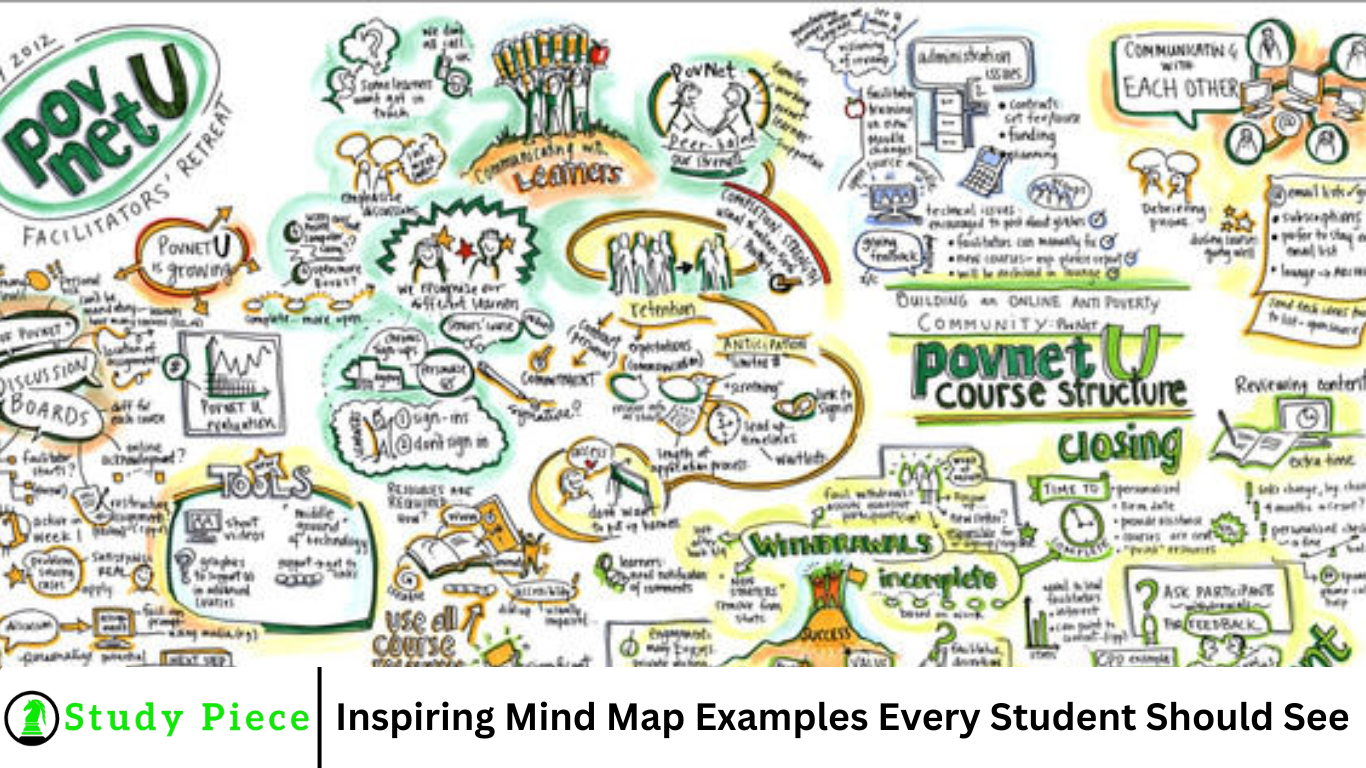Fast-paced academic environment, students face a constant barrage of information—notes, assignments, research, and ideas. Mind maps offer a creative and visual way to organize and retain information, making complex topics manageable.
This article explores mind mapping techniques, shares compelling examples, and offers tips tailored for students seeking to elevate their learning.
More Read: Mastering Memory: Spaced Repetition and the 2-3-5-7 Method
1. What Is a Mind Map?
A mind map is a visual method of organizing information around a central topic. Starting from a core concept (usually at the center), students branch out into related subtopics and ideas, creating a structure reminiscent of a tree. This radial hierarchy encourages nonlinear thinking and aids memory recall—far more effective than traditional outlines or flat notes.
2. Why Mind Mapping Is Effective for Students
- Enhances Memory Retention: Visual associations and hierarchical structures help the brain encode information more deeply.
- Improves Organization: Subtopics, keywords, and visuals arranged logically reduce clutter and boost clarity.
- Promotes Creativity: The freedom to connect ideas in multiple directions stimulates innovative thinking.
- Supports Time Management: Breaking large tasks into smaller, manageable branches allows for easier planning and prioritization.
- Engages Multiple Learning Styles: Mind maps appeal to visual, kinesthetic, and even auditory learners (when verbalized).
3. Types of Mind Maps
- Concept Maps – Emphasize relationships and cross-links between ideas.
- Spider Diagrams – Simple, radial-style brain dumps around a central theme.
- Flowcharts / Process Maps – Show step-by-step processes or timelines.
- Tree Diagrams – Break ideas into clear hierarchical branches.
- Double-Bubble Maps – Compare and contrast two ideas visually.
- Cluster Diagrams – Group related ideas in islands radiating from a central node.
4. Best Practices for Creating Mind Maps
- Start with a strong central idea, represented by an image or short phrase.
- Use one-word branches to keep concepts crisp and memorable.
- Employ colors and icons to differentiate topics and trigger memory.
- Add images or doodles—our brains process visuals 60,000× faster than text.
- Limit branching to 3–5 levels—too much depth overwhelms readability.
- Show links between branches to represent cross-connections.
- Review and refine—add, reorganize, or simplify as needed.
5. Inspiring Mind Map Examples for Students
A. Subject-Based Mind Maps
1. Biology: The Human Digestive System
- Central Node: “Digestive System”
- Primary Branches: Mouth, Esophagus, Stomach, Small Intestine, Large Intestine, Liver & Pancreas
- Sub-branches: Functions, Enzymes, pH levels
- Visuals: Color-coded organs, icons for enzymes (e.g., amylase as a small swoosh)
This visual aid helps students see how each organ interacts, improving retention during exam prep.
2. History: World War II Causes & Effects
- Central Node: “World War II”
- Branches: Causes (Treaty of Versailles, Rise of Fascism, Economic Depression), Key Events, Consequences (Political, Social, Technological)
- Color Coding: Pre-war (blue), During war (red), Post-war (green)
This structured snapshot makes it easy to recall complex historical narratives.
B. Project & Research Mind Maps
1. Science Fair Project
- Central Node: Project title (e.g., “Solar Panel Efficiency”)
- Branches: Hypothesis, Methodology, Materials, Data Collection, Analysis, Conclusion
- Icons: Beakers, graphs, solar panel sketches
This ensures each phase is addressed methodically while enabling mid-project adjustments.
2. Literature Review Mind Map
- Central Node: Main Thesis
- Branches: Theoretical Frameworks, Key Studies, Methodologies, Gaps in Research
- Cross-links: Connections between studies, contrasting theories
Perfect for thesis, dissertation, or term paper planning.
C. Creative & Brainstorming Mind Maps
1. Personal Goal Mapping
- Central Node: “My Goals 2025”
- Branches: Academic, Personal, Extracurricular
- Sub-branches: GPA targets, fitness routines, club leadership
- Icons & Colors: Dumbbell for fitness, book for academic, paintbrush for personal
Encourages holistic life planning embedded in a clear visualization.
2. Writing Project Brainstorm
- Central Node: “Short Story – Space Adventure”
- Branches: Characters, Plot, Setting, Conflict, Themes
- Sub-branches: Character traits, twists, setting details
This jumpstarts the creative writing process and prevents writer’s block.
6. How to Choose the Right Mind Mapping Tool
A. Free vs. Paid Tools
- Free: XMind, FreeMind, Coggle (basic plan)
- Paid: MindMeister, iThoughts, MindManager (advanced features like collaboration, task integration)
B. Platform Compatibility
- Cross-platform web apps (XMind, Coggle) sync across devices.
- Native desktop/mobile apps (iThoughts for iOS, MindManager for Windows) may offer speed and offline usability.
C. Must-have Features
- Collaboration: Real-time sharing for group projects
- Export Options: PDF, PNG, Word, PowerPoint
- Templates: Academic-specific layout options
- Integration: With task tools (Trello, Asana), note apps, and cloud storage
7. Tips to Maximize Mind Mapping Efficiency
- Schedule mapping sessions on Sundays for weekly planning or before exams.
- Incorporate spaced review—regularly revisit maps to reinforce memory.
- Use mind maps as study tools by covering branches and self-testing.
- Share with peers—peer feedback can uncover missing elements.
- Update maps dynamically, especially for projects with evolving requirements.
- Link to resources, like attaching source PDFs or linked documents in digital maps.
8. Real-World Success Stories
- University Student — Biology Major: Switched from linear notes to mapping for finals; saw a 15% increase in recall score.
- High School Debater: Used mind maps to prepare pros and cons for debate topics, greatly enhancing articulation and structure.
- Creative Writing Club: Employed brainstorming maps to generate story arcs, increasing club output by 40%.
These anecdotal wins underscore the adaptability and impact of mind mapping across disciplines.
Frequently Asked Question
What are mind maps, and why are they useful for students?
Mind maps are visual diagrams used to organize ideas around a central topic. They help students retain information, understand complex subjects, and boost creativity by showing how ideas connect. They’re especially effective for revision, brainstorming, and project planning.
What subjects are best suited for mind mapping?
Mind maps work well across most subjects. They’re especially helpful in:
- Science (e.g., biology processes)
- History (e.g., timelines and events)
- Literature (e.g., character and plot analysis)
- Math (e.g., formula connections)
- Languages (e.g., vocabulary and grammar rules)
How can students use mind maps for studying?
Students can use mind maps to:
- Summarize textbook chapters
- Create revision guides
- Break down essays or research papers
- Review class notes visually
- Practice active recall before exams
Are digital mind maps better than hand-drawn ones?
Both have advantages. Digital mind maps (e.g., XMind, MindMeister) are great for editing, organizing, and sharing. Hand-drawn maps may enhance memory through the act of writing and drawing. It often depends on personal preference and the task at hand.
What are some inspiring mind map examples for students?
Examples include:
- A biology mind map showing the human circulatory system
- A history mind map explaining the causes and effects of World War II
- A literature map breaking down a novel’s characters and themes
- A goal-setting map outlining personal, academic, and career goals
These examples help students visually understand and recall information more effectively.
Can mind maps help with group projects?
Yes! Mind maps are ideal for collaborative brainstorming and dividing tasks in group projects. Using tools like Coggle or Lucidchart, students can co-create maps in real-time and keep everyone aligned.
How often should students use mind maps?
Students should use mind maps regularly—especially:
- At the start of new topics
- When preparing for exams
- During project planning
- After each class to review and summarize notes
Conclusion
Mind mapping is a powerful and versatile tool that can transform the way students learn, organize, and express their ideas. Whether you’re tackling complex subjects, planning projects, or brainstorming creatively, mind maps offer a clear visual structure that enhances understanding and memory. By exploring and applying inspiring mind map examples, students can boost productivity, reduce study stress, and unlock new levels of academic success. Start mapping today—and turn scattered thoughts into structured success!



